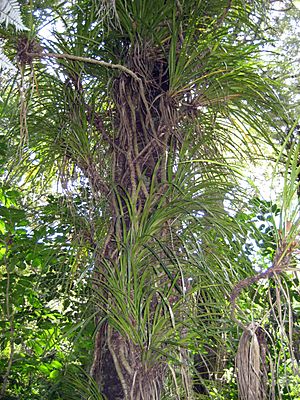Kiekie (plant) facts for kids
Quick facts for kids Kiekie |
|
|---|---|
 |
|
| Kiekie climbing a Kohekohe tree | |
| Scientific classification | |
| Genus: |
Freycinetia
|
| Species: |
banksii
|
| Synonyms | |
|
|
The Kiekie (Freycinetia banksii) is a special plant from New Zealand. It's a woody plant that loves to climb. It belongs to a plant family called Pandanaceae, also known as the screwpalm family.
Kiekie has many strong, cane-like stems. These stems can grow up to 40 millimeters (about 1.5 inches) thick. They often grow roots right from the air! Kiekie uses these roots to climb up tree trunks. It can also form thick, tangled mats on the forest floor. Its stems and leaves are a common sight in many New Zealand forests. The stems can grow very long, sometimes up to 30 meters (about 100 feet)! Its leaves are long and thin, usually 60–90 centimeters (2-3 feet) long and 2-2.5 centimeters (about 1 inch) wide.
Where Kiekie Grows
Kiekie can be found in forests all over the North Island of New Zealand. In the South Island, you'll see more kiekie in places that get a lot of rain. It grows as far south as the Clarence River in the east. In the west, it reaches down to Fiordland.
Kiekie's Many Uses
The Māori found many uses for the kiekie plant. They loved to eat its sweet fruits. The soft, juicy parts around the flowers, called tāwhara, were also a tasty treat. People often used a special forked stick to gather these delicious parts.
Kiekie leaves were widely used for weaving and plaiting. While the wider leaves of New Zealand flax were often preferred, kiekie was special. Its leaves were great for making items that needed to be woven very tightly. Examples include small, finely woven baskets called kete pūtea and kete pure. People also wove mats and temporary baskets for holding food. The aerial roots of the kiekie plant were also useful. They were gathered and used as a strong material for tying things together. People also used them to make fish traps and even sandals!
See also
 In Spanish: Kiekie para niños
In Spanish: Kiekie para niños



